728x90

Location: Montreal, Canada
Project year: 1992-2006
Architect Team: Michel Languedoc (project architect), Mario Saia (director of design). Team members: Dino Barbarese, Vladimir Topouzanov, Trong Tuan Nguyen, Sylvain Bastien, Michel Beauchemin, Richard Beaudoin, Nicolas Bokobza, Patrick De Barros, Suzanne Essiambre, Naomi Frangos, Cathy Gagnon, David Griffin, Vivian Irschick, Laurence Kerr, Jean-Louis Leger, Pascal Lessard, Julie Marchand, Yvan Marion, Nadia Meratla. Marie-Eve Methot, Annie Morrissette, Marc Pape, Louis-Guillaume Paquet, Marianne Potvin, Steve Proulx, Pascal Roffi, Veronique Roy, Annie-Claude Sauve, Yvon Theoret, Sam Yip
Landscape: Claude Cormier architectes paysagistes inc.
General Contractor: Herve Pomerleau inc.
Site Area: 5,000 sqm
Constructed Area: 63,215 sqm
Photographs: Marc Cramer, Nathalie St-Pierre, Ivanoh Demers, Michel Brunelle, Jean-Francois Vezina, Claude Duchaine, Andrew Dobrowolskyj




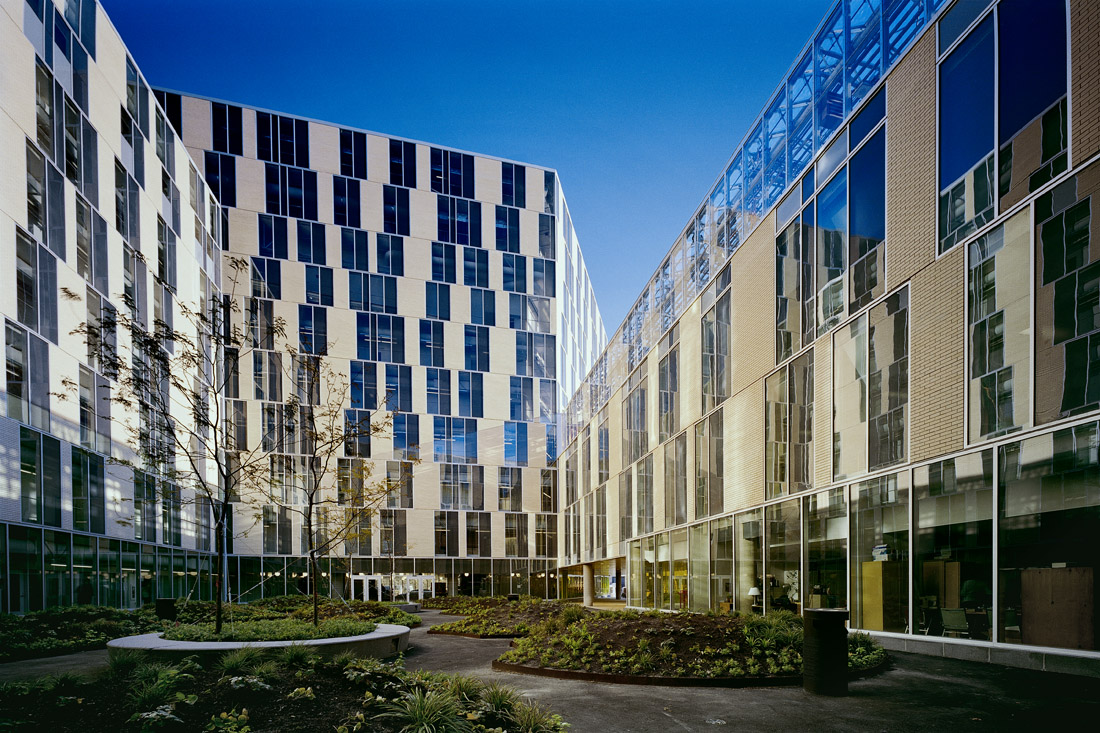



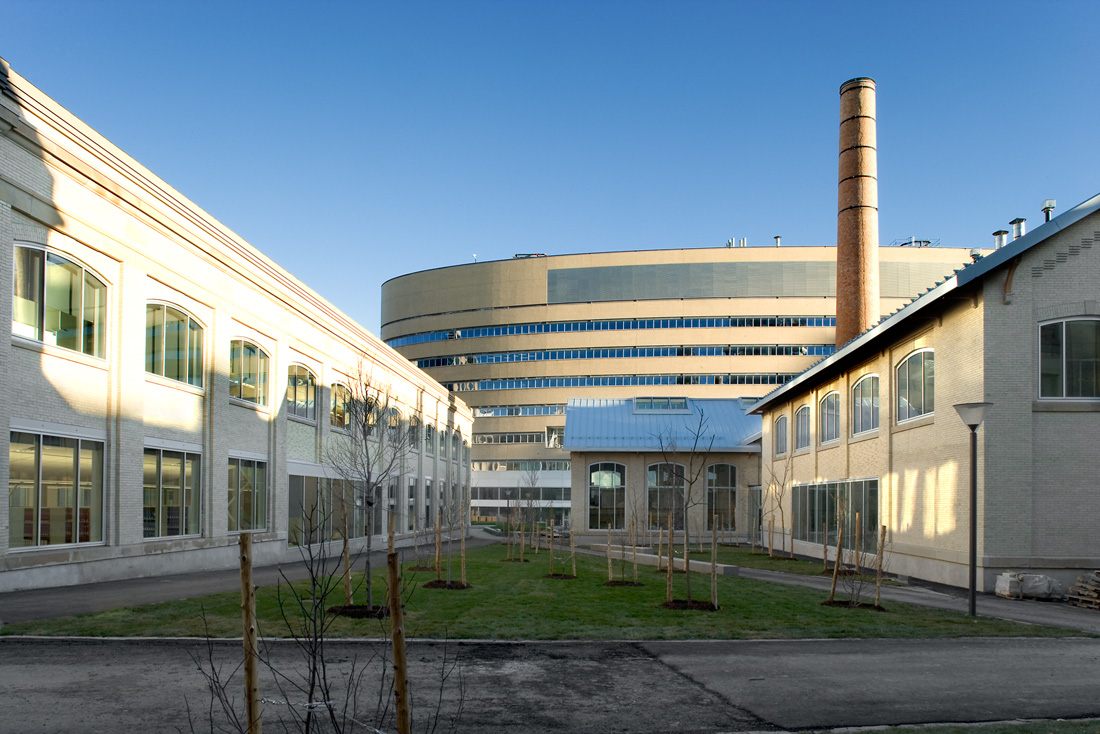





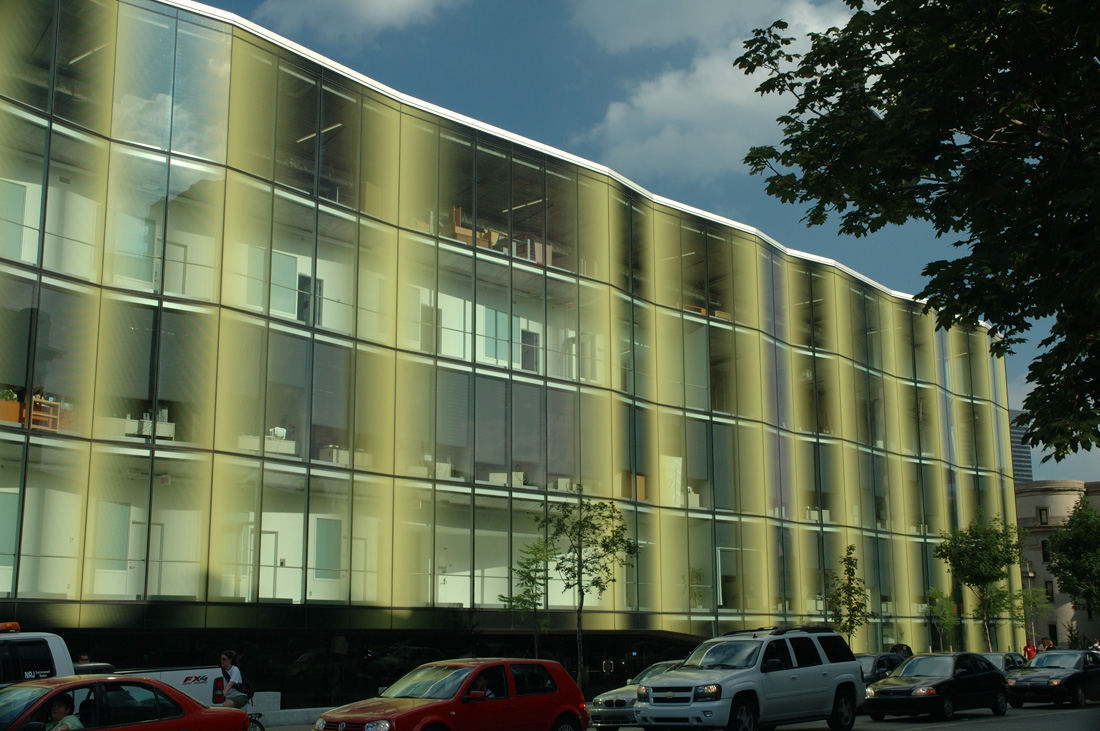




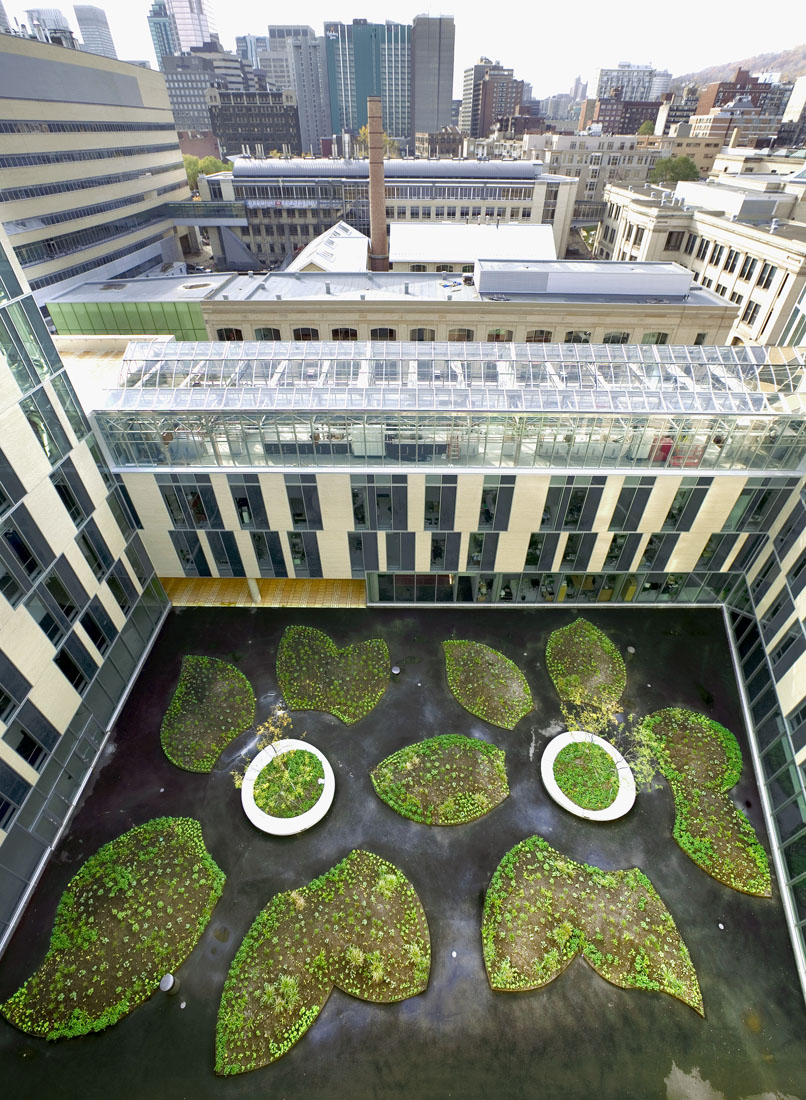
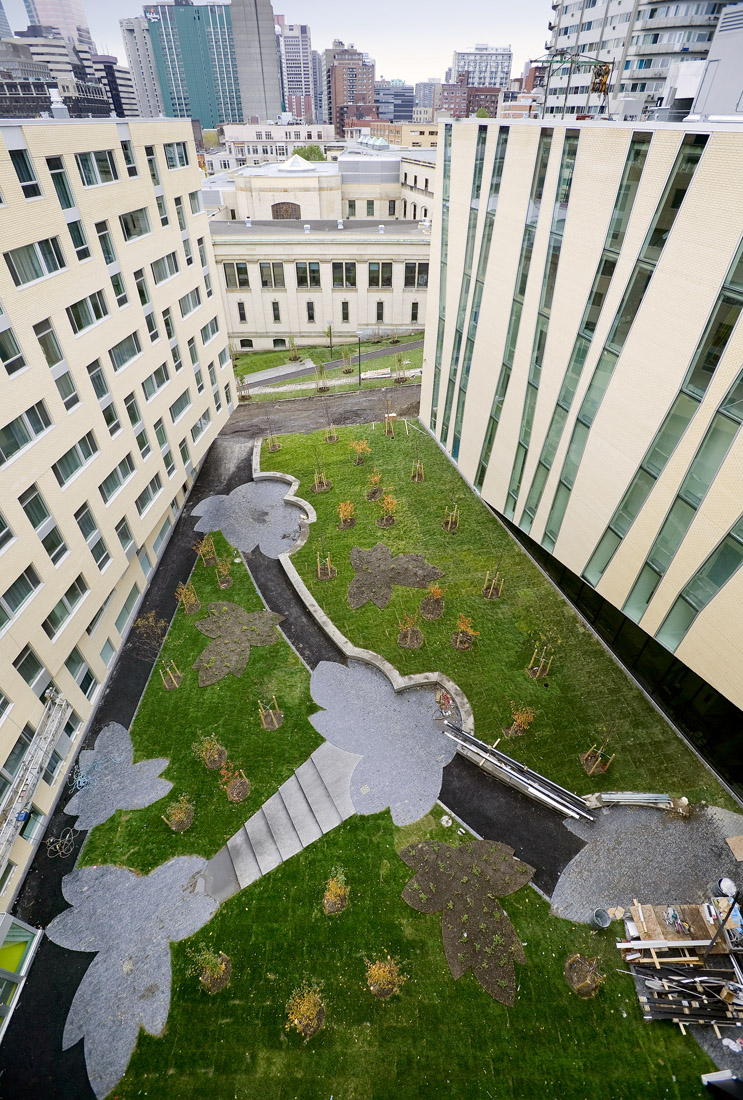






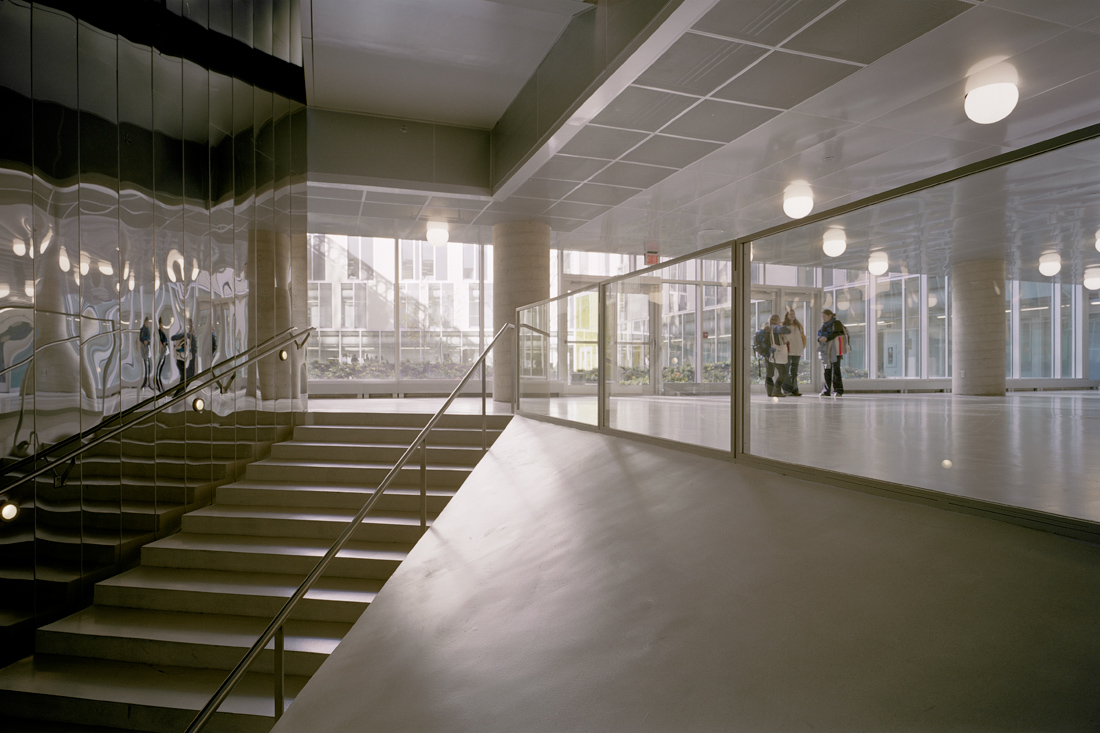

The urban planning of the campus acknowledges the diverse urban character of the immediate context at the heart of Montreal’s historic cultural artery. The master plan sets out to reweave a tattered piece of the urban fabric, with the eastern portion of the site previously occupied by a parking lot now engaged in the vital life of the city with the addition of three new pavilions containing the faculty of Biological Sciences, TELUQ, and a new student residence.
landscape
The first big move of the urban plan was to restore the importance of the north-south cultural axis by creating a new pedestrian route through the site. The reinstatement of Kimberley Street as a pedestrian route separates the site into two distinct landscape domains.
To the west, a series of triangular gardens surrounds the site’s existing buildings (including industrial buildings that date back to 1911), which become pavilions in a garden of densely planted trees. Respectful incorporation, restoration and conservation of the historic buildings played an important role in the environmental philosophy of the master plan. A former foundry building will soon become the centre for student and social activity; the adjacent power plant serves as a hub for high-tech media-related activity, its preserved chimney a vertical orientation device visible anywhere on campus; a renovation to the Kimberley Pavilion converts it to a library whose luminous, transparent addition acts as a lantern of light.
To the east, the new buildings gravitate to the perimeter of the campus block, creating a strong urban identity that uses UQAM’s trademark buff brick applied uniquely to each building to give them individual character and personality. This edge forms a strong but porous interface with the city: a series of porte-cocheres leading to individually landscaped courts provides an open membrane between the city and the university.
Sustainability features of the plan include the initial decision to remediate and redevelop an urban brownfield site, the adaptive re-use of a number of historic buildings, the installation of 225 bicycle parking spots, and access to the subway directly from the Biological Sciences pavilion, slated to obtain LEED certification for sustainable design.
About the Urban Design and Architecture Team
This consortium brought together two of Montreal’s most respected architecture firms, a group of professionals in architecture, urban design, building science, sustainable design and site supervision. Established in 1968, Saia Barbarese Topouzanov architectes has won numerous prestigious awards and citations, including two Governor General Medals. The highly acclaimed firm is recognized for its commitment to quality, and has developed a distinct expertise all aspects of architecture and urban design. Les architectes Tetreault Parent Languedoc et associes, founded in 1970, is a leading architectural firm deeply involved in institutional projects, such as museums, health and welfare facilities, industrial projects, and computerized environments for intelligent buildings. Previous collaborations by the consortium include the widely published Montreal Convention Center Expansion.
UQAM ARCHITECTURE
The western sector of the site has been revitalized with the renovation of an amphitheatre and existing structure of the beaux-arts technical institute that has occupied the site since 1917. A new Sciences library reprograms a disused studio building, its new glass addition a transparent beacon symbolizing the vibrant collage of new and old. The campus receives a new heart with the renovation (still in progress) of an existing foundry and power plant. This powerful space is pared back to the simplicity of early-20th-century steel trusses and dramatic open volumes, serving as a new centre for discussions and public forums on the subject of Science and Society.
masterplan
Three new buildings on the east side of the campus share a number of democratizing principles, yet each is individualized to adapt to its specific program and site conditions. An architectural vocabulary of perimeter block courtyard buildings present luminous glazed entry portals to the street. The massing of these buildings is carefully considered, with the geometry of their upper levels spiraling in height and gently deflecting to bring light into the landscaped courts.
The new campus buildings recombine the material palate of the surrounding structures in a bold, symbolic cladding strategy. UQAM’s “trademark” buff brick, gray brick, as well as transparent and transluscent coloured glass are used to create a family of patterns. The use of buff brick for its light-reflecting qualities emphasizes the importance of light in the overall planning.
Biological Sciences Pavilion
The largest of the new buildings, the Biological Sciences pavilion, embodies UQAM’s spirit of democracy and accessibility in its architectural expression. The public nature of the building is emphasized in the luminous entry from St-Urbain Street. This illuminated porte-cochere slips beneath a DNA-patterned skin of glass and brick, leading to the subway entrance below grade or through the building to the landscaped court at its centre. This cladding, which evokes the spirit of scientific exploration of the building program it contains, wraps both the street and court-facing surfaces of the building, changing to translucent yellow and grey glass where it faces St. John the Evangelist Church at the south end of the site to provide an interesting reflection of the historic structure in its facade.
The potential for well-designed public space to result in collaboration is emphasized in the internal layout, whereby the single-loaded transparent corridors at the upper levels are given the most privileged position around the perimeter of the courts. The laboratories are designed specifically for the project-based learning model that is at the heart of UQAM’s innovative pedagogical philosophy, using real-life, practical problems to teach both critical and technical skills. An innovative modular laboratory planning concept subdivides the labs into 10-square-metre units serviced by vertical service shafts, so that each lab is autonomous and can be changed without interfering with the operations of adjacent labs.
TELUQ Pavilion
The TELUQ pavilion for distant learning and media broadcasting is one of two buildings that frame another court that spills out on one edge to the pedestrian street and the “city forest” beyond. The TELUQ pavilion is UQAM’s answer to the question, “What will a university look like in 20 years?” The virtual university has 40 professors whose innovative work in internet training serves as the heart of its distant education program, the largest francophone university of its kind.
The five-storey pavilion occupies the most public corner of the campus, presenting the intersection of Sherbrooke Street and St-Urbain Street with a subtly undulating curtain of glass that speaks to the dramatic nature of the media/broadcasting program contained within, and abstractly reflecting the adjacent historic buildings in its faceted surfaces. The curtain effect is further emphasized by a dot pattern, silk-screened onto the glass, that ranges from fully transparent to 100% coverage to create the illusion of depth. The lifting of the curtain at the corner marks the entry point. The pavilion’s court-facing facade is clad in the abstract form of tree trunks, inspired by the site’s distant history as a garden for exotic trees and animals. An oculus visually connects the main auditorium to the courtyard, reinforcing the connection between learning and the physical environment.
Student Residence
The L-shaped student residence is an eight-storey building that provides housing for 500 UQAM students and visiting professors. The residence wraps around a protected courtyard whose sloping planting beds are dotted with the shapes of over-scaled leaves. The residence rooms are arranged in a variety of configurations, including two-bedroom, three-bedroom, and four plus four bedroom units sharing a double-height corner common room. The residence is clad in a “swallow’s nest hatch” weave whose dynamic abstract pattern is unique to this building.
Coeur de Science: Science Library and Media Centre
The new “Science Heart” of the campus takes the form of new library in a historic studio building, and a new media and science agora in a renovated foundry and power plant building. The library re-occupies a historic building formerly used as a studio by the technical university that occupied the western section of the campus. Its transformation involved paring back the structure to its 1911 bones, and the addition of a glass extension containing the entrance and a lofty, light-filled reading room above. A red carpet painted on the floor guides users through the principle circulation route, leading up to the reading room on the second floor, and down to the expansive underground space dedicated to book storage located beneath Kimberley the street and lit from skylights above. The renovation of the foundry/power plant will provide an open agora for public events and discussions.
UQAM CITY FOREST
Highlights of UQAM’s landscape design, created by award-winning Montreal-based landscape firm Claude Cormier architectes paysagistes, include a “city forest” composed of five exotic species and 166 trees that create a serene canopy within a criss-crossing net of pathways across the campus. The landscape also features two idiosyncratic courtyard gardens that play with both the scale and the imagery of botanical materials.
The city forest on the historic west side of the campus gives the landscape a strong seasonal identity-bright yellow gingko colours the campus in the fall, an explosion of magnolia blossoms announces the end of the spring semester. The tree canopy’s sculptural branches allow light to penetrate in the winter; and in the summer, provide textured shadows. The horticultural palette also includes Kentucky coffee trees, honey locusts and Elm ‘Accolade’. These species were specifically chosen to create a high, diaphanous canopy that admits enough light for grass to grow beneath, eventually creating the sense of paths tracing through a grassy forest.
The irregular pattern of the paths acts as a counterpoint to the rather formal disposition of the historical buildings on the site, creating a series of campus shortcuts to the numerous access points that connect the campus to the city. The central pedestrian street is landscaped as an asymmetrical allee between the landscape of pavilions in a forest to the west, and the whimsical courtyard gardens at the centre of the new buildings to the east.
The courtyard of the Biological Sciences building centres around the super-scale shapes of two magnolia blossoms that appear as if seen under a microscope. The giant petals become colourful beds of low planting, the stamens are translated as tree branches. These figures become increasingly recognizable from higher up in the building, designed to be seen from the transparent circulation corridors that line the inner perimeter of the building.
A second courtyard, nestled between the TELUQ pavilion and the student residence, negotiates the dramatic change in grade with an open glade punctuated by the forms of several leaves scattered throughout the court. An oculus in the TELUQ building to the north provides a privileged view of this whimsical landscape feature from above.

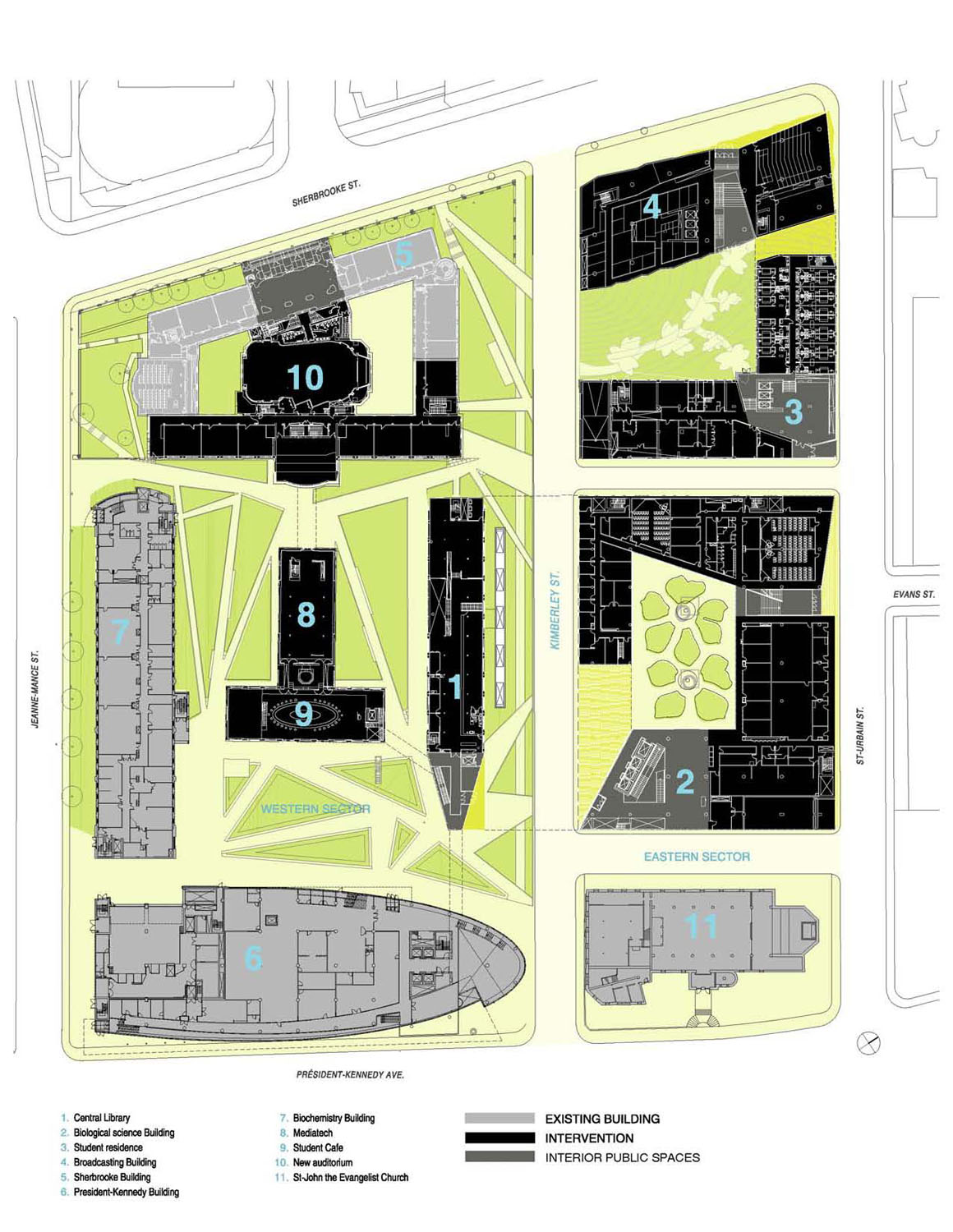

그리드형
'REF. > Architecture' 카테고리의 다른 글
| [ ah asociados ] Centro Sociocultural y Biblioteca en Mendillorri (0) | 2008.12.21 |
|---|---|
| [ Zaha Hadid Architects ] Library and Learning Centre at the University of Economics & Business by (0) | 2008.12.21 |
| [ Architects Collective & at103 ] Ozuluama Residence (0) | 2008.12.20 |
| [ ODOS architects ] Dwelling at Maytree (0) | 2008.12.20 |
| [ TAMABI ] Rio de Janeiro Residence (0) | 2008.12.19 |